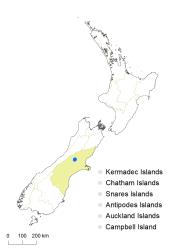Perennial herb, single rosette or with short lateral branches, stem and branches 1.0–1.5 mm diam., strongly rhizomatous. Leaves up to 80 mm long, pinnatisect; lamina 10.2–55.0 × 12.0–28.0 mm, grey-green, light green, greenish-yellow, sometimes purplish beneath, coriaceous, usually glabrous, occasionally with sparsely hairy margins and petiole. Terminal pinna 4.0–16.0 × 4.0–17.0 mm, usually simple, sometimes with 1–2 very shallow lobes, orbicular, orbicular-rhomboid, to broadly elliptic-rhomboid, margin often irregular, apex obtuse with a conspicuous hydathode, base obtuse, truncate or weakly cordate and sometimes oblique. Lateral pinnae 2–4, 2.0–11.0 × 2.0–10.0 mm, orbicular, orbicular-rhomboid, to broadly elliptic-rhomboid, petiolule 0.5–8.0 mm long. Petiole up to 65 mm long; hairs septate and 0.3–0.4 mm long. Cauline leaves similar to rosette leaves but smaller and with fewer lateral pinnae. Inflorescence racemose, 7–15-flowered; peduncle up to 140 mm long, 0.8–1.4 mm diam. at base, upright, glabrous. Pedicels 12.0–37.0 mm long, 0.4–0.5 mm diam., glabrous. Sepals 2.6–4.5 × 1.5–2.2 mm, elliptic-oblong to broadly elliptic, ± saccate, green or red-brown, usually glabrous or occasionally sparsely hairy in distal half, margin translucent or white, membranous, apex obtuse, base truncate. Petals 7.6–11.3 × 3.8–5.0 mm, white, limb obovate to broadly elliptic; apex obtuse; base cuneate, tapering to a 1.0–1.4 mm long claw. Stamens 6; median filaments 4, 3.6–4.0 mm long; lateral filaments 2, 3.2–3.4 mm long; anthers 0.8–0.9 mm long, cream to pale yellow, when dehiscent held at a similar height to or slightly below the stigma. Ovary 3.5–4.2 mm long, 0.5–0.6 mm diam., ± terete, green, glabrous; ovules 18–22; style 2.0–4.0 mm long, ± terete; stigma 0.7–0.8 mm diam. Siliques 33.0–40.0 × 1.5–1.8 mm, glabrous, style 1.8–3.0 mm long; valves green to red-brown at maturity; straw-coloured when dehiscent, replum 0.3–0.4 mm wide. Seeds 1.4–1.9 mm long, 0.7–1.1 mm wide, 0.3–0.5 mm thick, broad-oblong, oblong to oblong-elliptic, yellowbrown to henna; wing present.
At Castle Hill Basin, Cardamine magnifica occurs with C. coronata Heenan (2017: 49–51), C. glara and C. intonsa Heenan (2017: 106–109). In comparison to C. glara to which it is most similar, C. magnifica has a more robust growth habit, strongly rhizomatous stems, thicker, more robust and larger leaves, conspicuous and larger flowers, larger sepals and petals, longer anthers, filaments and styles, and longer seeds with a winged margin. Cardamine coronata is readily distinguished by its leaflet axillary hydathodes and the hairy silique, C. intonsa has hairy leaves and siliques, and both species have smaller sepals, petals, anthers, filaments, and seeds (see Heenan 2017).
New Zealand endemic, occurring in Canterbury. Cardamine magnifica is known from populations located at Castle Hill Basin (including Castle Hill, Gorge Hill, and Prebble Hill), Canterbury, South Island.
An obligate calcicole. C. magnifica typically occurs on fine-grained limestone scree, stony colluvium, and at the margins of associated sparsely vegetated, stable to semi-stable limestone rock outcrops and bluffs.
We recommend that Cardamine magnifica be assessed as Threatened, Nationally Critical, with the criterion “A” of very small population (natural or unnatural). Two of the Nationally Critical A subcriteria apply: A(1) < 250 mature individuals and A(3) total area of occupancy ≤ 1 hectare (Townsend et al. 2008). The qualifier DP (data poor) also applies due to the lack of population size and trend data (Townsend et al. 2008).
Flowering October–December; Fruiting December–March.




